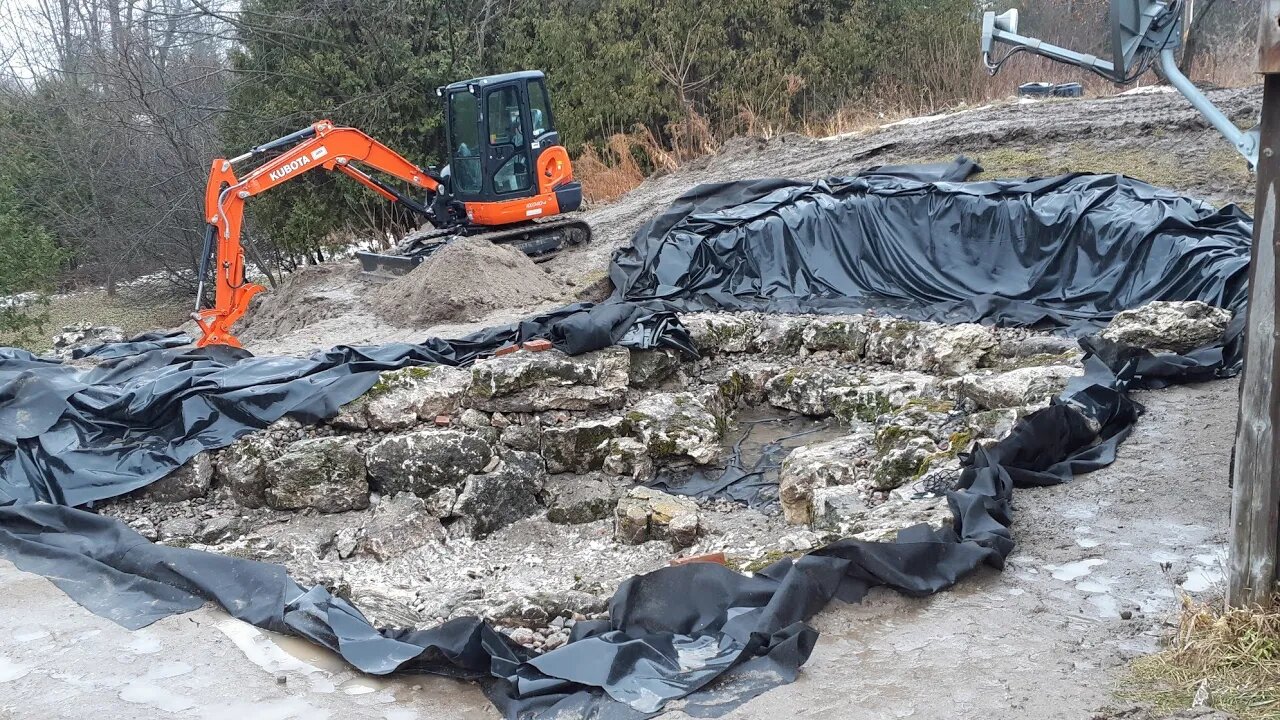Premium Only Content

Ecopond (sound needed to be removed for a song copyright, but I will leave the video up).
CARBON
I wanted to also discuss the carbon footprint aspects of this... I did a ton of research on what the carbon balance of a project like this would look like.
I didn't want to get into too much of a conversation in the video because it may turn it a bit dry and long. The carbon footprint of this pond is significant, which was a big wrestling point for me in building it. My entire last 5 years has been on trying to go zero, or even negative on carbon as my family's footprint. It was due to this that I did more natural "hole in the ground" ponds.
So far I have roughly 5 ponds and a 100-ish foot stream that I have dug with just a shovel, a sore back and a few hundred hours of my time. It has been a long haul doing this slowly over the last few years - a weekend here, a weekend there. I'm quite pleased with what I have been able to accomplish with this, but there are a few "issues" with normal ponds.
1) The entire volume of water of the pond is continuously exposed to sunlight. This is fairly natural, but what many clean-water well aerated ponds have is that they connect to an underground aquifer as a feed source. I have tried to replicate that in other ponds (basically trying to get French ditch drains dug as the feed source), but, well, it's not easy with a shovel to get 8+ feet deep through roots and such. Also, I have no long term assurance that this won't just tunnel a new hole bypassing the ponds.
Digging 15 foot holes to create giant underground reservoirs which simulate aquifers is simply not possible with a shovel. Digging 12 foot deep holes to create deep oxygen storage zones of the pond is simply not possible for me on a fairly wet site. Once I get 3 feet down, I'm in water, and I cannot get lower. So, to do a "proper" pond, using wetland science to maximize various benefits - it's just not possible without an excavator. I considered purchasing one, renting one, or renting an expert with one, and economically the latter was the best option.
I still have small pocket "hole" ponds, but I did want the heart of my food forest to be a near-permanent, well done project, which would outlive me. Even if the power is shut off, and the pumps no longer work, this pond will be 80% as effective as it is with motive force moving the water, and will be 200% as effective as a "hole in the ground" pond - due to the proper engineering design of various "layers" of the pond - combined with the passive systems such as water catchment.
2) Filtration and water movement is crucial - typically through filtered reedbeds. I can divert my house runoff through a system like this, but for a standing pond, the only real reliable way to accomplish this is via external power. It would be nice to tap into my stream as a constant addition/overflow style system, but alas the regulations do not allow for this. So I have come to grips with the fact that I either risk heavy sanctions and tap into it regardless, or I abide by local laws, and move towards storage+ external motive force (pumps). I have settled on the latter.
3) Because I have settled on the latter, using pumps - I now have a mission, a RESPONSIBILITY for that choice, to make this power as green as possible. There are a few ways I can accomplish this - more notably energy storage and solar photovoltaics, but also off-hours timers. My local energy is nearly 100% green (nuclear) after peak hours, and each year our grid gets greener and greener.
As for PVs, I am waiting on Canadian election (Liberal minority) to help put some new incentives towards PVs. My goal, and again, my personal accountability, is to get this power source to be 100% renewables at all times.
4) Talking along the responsibility and environmental stewardship aspects - I am also going to be using this pond to sequester as much carbon as possible. Not only will the pond allow me power-free irrigation of all plants on my land (I can gravity feed well oxygenated nutrient rich pond water drip system due to the elevation of this pond), but I can pursue other "projects".
One such project is going to be trying to replicate - on a very small scale - [the azolla event](https://en.wikipedia.org/wiki/Azolla_event).
5) This pond will offer tremendous opportunities for high oxygen content water to be used in hardwood propagation. which I can then use in my other hobby - forest restoration.
With all these things, I am confident that I can spend this carbon in order to jam more in the ground than this project "costs". A big part of that will be to get the maintenance carbon (the energy for pumps) 100% green. The second big part will be to turn this pond into a propagation machine which can get me planting thousands of trees per year.
-
 17:16
17:16
Permaculture
1 year ago $0.07 earnedStarting Seeds guide - seeds and growing media
4462 -
 1:09:53
1:09:53
Slightly Offensive
7 hours ago $6.68 earnedIs the US Headed for MORE WAR Under TRUMP? | Guest: Scott Horton
41.9K9 -
 58:29
58:29
The StoneZONE with Roger Stone
7 hours agoRoger Stone Hails Confirmation of Kash Patel, Trashes Schiff for Attacks On Patel | The StoneZONE
48.9K19 -
 48:44
48:44
Man in America
12 hours agoA MASSIVE Global Financial Reset Is Coming—Are You Ready?
41.6K12 -
 1:15:42
1:15:42
Precision Rifle Network
1 day agoS4E5 Guns & Grub - The Best Rifle Under $2000
69K6 -
 1:02:54
1:02:54
Glenn Greenwald
1 day agoSouth Korean Economist Ha-Joon Chang on the Economic World Order, Trump's Tariffs, China & More | SYSTEM UPDATE #410
89.2K50 -
 1:02:27
1:02:27
Donald Trump Jr.
12 hours agoBye Mitch, plus Kash confirmed, Interview with AJ Rice | Triggered Ep.218
134K75 -
 1:12:27
1:12:27
The Amber May Show
14 hours ago $3.12 earnedWomen Of Rumble 02-20-25
36K8 -
 41:18
41:18
Kimberly Guilfoyle
12 hours agoToday, We Kash in on Equal Justice, Live with Ryan Walters & Daniel Turner | Ep.198
98.9K22 -
 1:36:50
1:36:50
Redacted News
11 hours agoThe TRUTH in Ukraine has been EXPOSED by Trump and they are melting down | Redacted w Clayton Morris
139K231